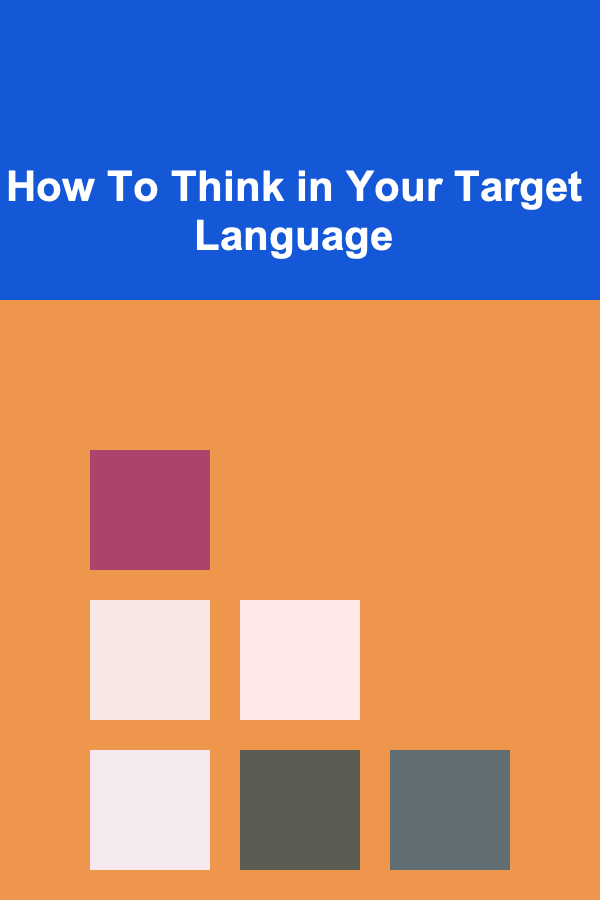
How To Think in Your Target Language
ebook include PDF & Audio bundle (Micro Guide)
$12.99$5.99
Limited Time Offer! Order within the next:

Thinking in your target language is often considered one of the most significant milestones in language learning. It represents a deeper, more immersive level of fluency that goes beyond memorizing vocabulary and grammar rules. When you can think in your target language, it indicates that you've internalized the language to the point where it becomes second nature, reducing the need for translation and allowing you to express yourself more naturally.
In this article, we will explore the concept of thinking in your target language, why it's crucial for fluency, and practical strategies to develop this skill. By the end of this guide, you will have a clearer understanding of how to think directly in your target language and integrate it into your daily life.
Why Thinking in Your Target Language Matters
The Process of Learning a Language
When you first start learning a new language, your brain works by translating everything from your native language into the target language. This translation process may feel natural at first, as it aligns with your existing knowledge. However, over time, this approach can slow you down, especially when speaking or listening. Translation requires time and cognitive effort, and it can lead to awkward pauses or errors.
The key to fluency lies in being able to bypass this translation phase and begin thinking directly in the target language. Once you can do this, you'll start understanding the language at a deeper level, without needing to constantly refer back to your native language.
The Benefits of Thinking in Your Target Language
- Increased Fluency: When you think directly in your target language, you remove the need for translation, which can make your speech and writing flow more smoothly.
- Improved Comprehension: You'll start understanding native speakers more naturally, even when they use slang or idiomatic expressions that you might have to translate if you were thinking in your native language.
- Enhanced Memory Retention: By immersing yourself fully in the target language, you reinforce your vocabulary and grammar in a way that makes them more memorable.
- Greater Confidence: The more you think in your target language, the more comfortable you'll feel using it in real-life situations, whether in conversations, writing, or other contexts.
How Your Brain Adapts to a New Language
When learning a new language, your brain undergoes several changes. Initially, it relies heavily on the translation process, as you are essentially building connections between the words in your native language and the new language. However, over time, as you accumulate more vocabulary and become more comfortable with the grammar, your brain begins to form direct associations between words in the target language. This shift helps you start thinking in the language, bypassing the need to translate.
The more you immerse yourself in your target language, the quicker this transition happens. This is why immersion---living in a country where the language is spoken, consuming media in the language, and interacting with native speakers---is one of the most effective ways to develop fluency and start thinking in the language.
Practical Steps to Start Thinking in Your Target Language
1. Immersive Listening and Reading
One of the best ways to begin thinking in your target language is to surround yourself with it as much as possible. The more you hear and read the language, the more natural it will feel to think in it.
Listening Practices
- Podcasts and Audiobooks: Listen to podcasts, audiobooks, and radio stations in your target language. Choose topics that interest you so that you are motivated to continue listening. Over time, your brain will start processing information in the target language, and you'll be less reliant on translation.
- Movies and TV Shows: Watching movies and TV shows in your target language, especially with subtitles in the same language, is an excellent way to immerse yourself. Initially, you might want to use subtitles in your native language, but as you progress, switch to subtitles in the target language or even watch without them entirely.
- Interactive Content: If possible, engage with interactive content like language-learning apps that have listening exercises. These can be helpful in familiarizing yourself with the way words sound in context, reducing the cognitive load when you need to understand them later.
Reading Practices
- Books and Articles: Start by reading books, news articles, or blogs in your target language. Begin with simpler materials and gradually increase the complexity as your vocabulary improves.
- Digital Tools: Use digital platforms like Duolingo, Babbel, or LingQ to help you read in your target language in a way that's tailored to your proficiency level.
- E-books and Dictionaries: As you read, make use of dictionaries or language apps to look up unfamiliar words. However, try not to translate everything---contextual understanding can often help you figure out meanings without relying on a direct translation.
2. Speak and Think Aloud in Your Target Language
One of the fastest ways to start thinking in your target language is to speak in it as often as possible. While this can feel intimidating at first, it's essential for training your brain to process the language on its own.
- Narrate Your Day: Try narrating your day in your head in the target language. For example, as you go through your morning routine, say things like, "I'm brushing my teeth," or "Now I'm making coffee" in your target language. This practice helps you move away from translation and start forming direct associations with the language.
- Talking to Yourself: Speaking to yourself, even if it's just repeating words and phrases you've learned, is a great way to familiarize yourself with the rhythms and structures of the language. Over time, your brain will start to respond automatically in your target language when you speak aloud, helping to reduce the reliance on your native language.
- Engage with Language Exchange Partners: Practicing with native speakers through language exchange platforms like Tandem, HelloTalk, or iTalki can also help. Speaking with real people allows you to apply what you've learned in authentic situations, pushing you to think on your feet.
3. Think in Context, Not Words
When learning a language, it's easy to focus on memorizing isolated words and phrases. However, language isn't just about individual vocabulary---it's about how words interact and form sentences. To think in your target language, start focusing on context rather than isolated vocabulary.
- Visualize Contexts: When learning new vocabulary, visualize a scenario where that word might be used. For instance, instead of memorizing a word like "apple," imagine yourself at a market, buying an apple, and hearing someone ask if you want a red or green one.
- Use Sentences, Not Words: Focus on learning phrases and sentences rather than isolated words. When you learn a word, try to memorize it within a context or a sentence. This helps you think more naturally, as it's easier to recall a sentence than an isolated word.
4. Use Technology to Your Advantage
In today's digital age, there are countless tools to help you practice thinking in your target language. From flashcards to immersion tools, technology can make the learning process much easier.
- Language Apps: Apps like Anki, Memrise, and FluentU are great for building vocabulary and understanding grammar in context. FluentU, in particular, uses real-world videos like music videos, movie trailers, and more, turning them into language lessons.
- Voice Assistants and AI Tools: Use voice assistants (like Siri, Google Assistant, or Alexa) in your target language. This will force you to think and respond in the target language, training your brain to process information directly in that language.
- Online Communities: Join online forums, groups, or social media communities that use your target language. Platforms like Reddit or Facebook often have groups dedicated to language learners, allowing you to practice thinking and writing in the language regularly.
5. Set Realistic Goals
Thinking in your target language doesn't happen overnight. It takes time and consistent effort to rewire your brain. Set small, achievable goals that focus on integrating the language into your daily life.
- Daily Word Count: Set a goal to learn a specific number of new words each day. Use them in sentences and try to recall them when you think or speak in the language.
- Weekly Challenges: Set weekly challenges for yourself, such as having a conversation in your target language for 15 minutes a day or reading an article without translating any words.
- Track Your Progress: Keep a journal or a log of your progress. Reflect on the moments when you were able to think or speak in your target language without hesitation. This can be a great way to motivate yourself and see how far you've come.
6. Embrace Mistakes and Failures
One of the biggest barriers to thinking in your target language is the fear of making mistakes. It's important to understand that mistakes are a natural part of the learning process. They are the stepping stones to fluency.
- Practice Without Judgment: Don't worry about making errors when you speak or write in your target language. Instead, focus on expressing yourself and learning from the feedback you receive.
- Celebrate Small Wins: Each time you catch yourself thinking or speaking in your target language without translating, celebrate it as a small victory. These moments are proof that you are moving closer to fluency.
Conclusion
Thinking in your target language is a vital skill that will dramatically improve your fluency, comprehension, and confidence. By immersing yourself in the language, speaking and thinking aloud, focusing on context, using technology, and setting realistic goals, you can accelerate your journey toward thinking directly in the language. Remember, language learning is a gradual process, and with consistent practice and patience, you will eventually find yourself thinking in your target language without even realizing it. Keep pushing forward, embrace your mistakes, and enjoy the journey of becoming fluent in your new language!

How to Celebrate Seasonal Milestones with Organized Events
Read More
How to Create Mood Lighting in Your Living Room
Read More
How to Maximize Your Attic for Space-Saving Storage
Read More
How to Mix and Match Party Themes for an Eclectic Home Gathering
Read More
How To Understand the Privacy Risks of Geolocation Data
Read More
How to Research Marine Ecotoxicology
Read MoreOther Products

How to Celebrate Seasonal Milestones with Organized Events
Read More
How to Create Mood Lighting in Your Living Room
Read More
How to Maximize Your Attic for Space-Saving Storage
Read More
How to Mix and Match Party Themes for an Eclectic Home Gathering
Read More
How To Understand the Privacy Risks of Geolocation Data
Read More